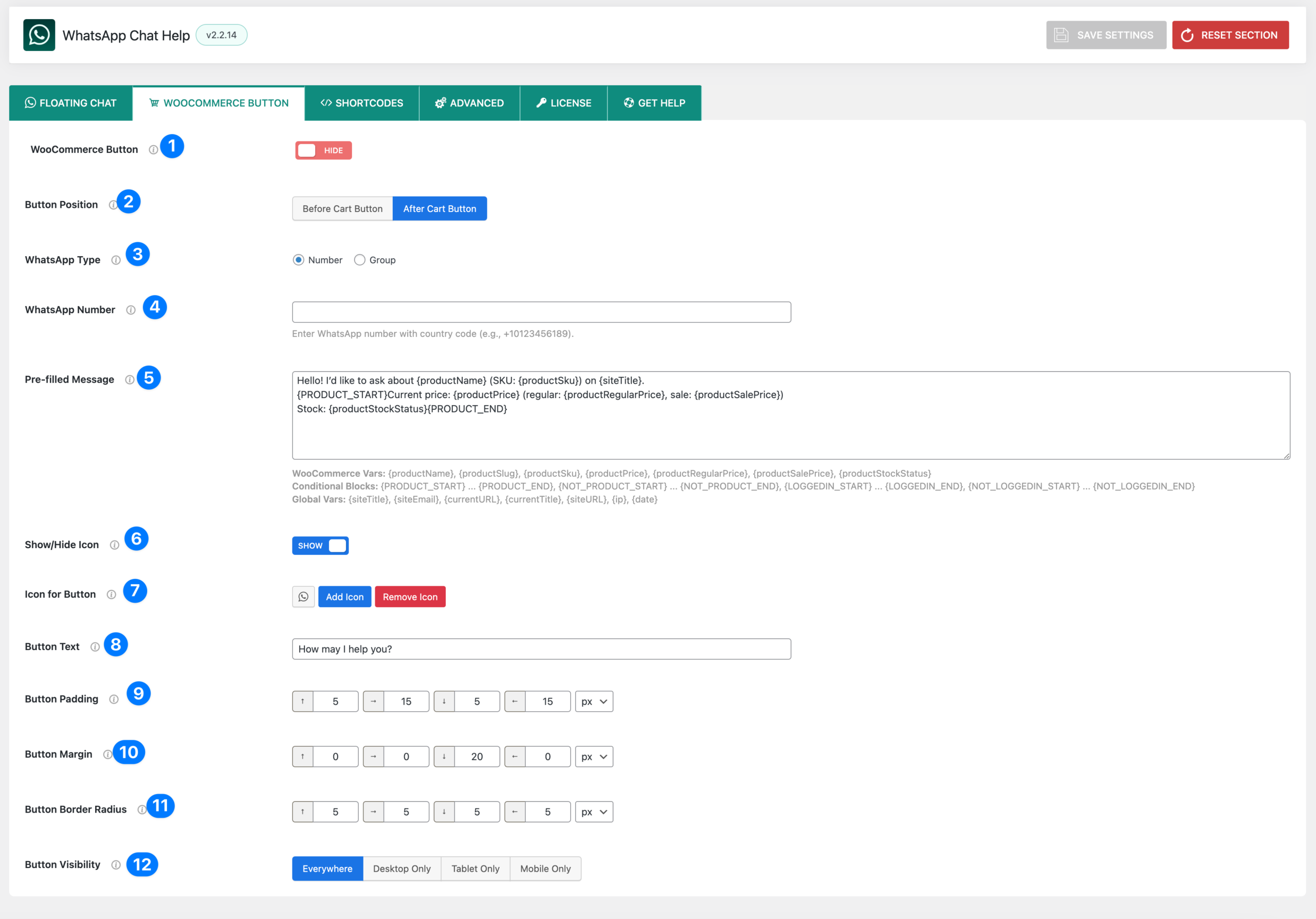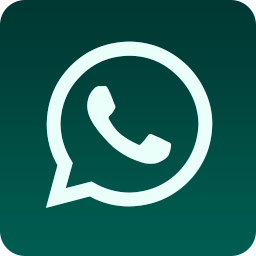The WooCommerce Button feature allows you to add a WhatsApp button directly to your WooCommerce product pages. This enables customers to reach out instantly with product-specific inquiries.

- WooCommerce Button Toggle
- Enable / Disable the WooCommerce button.
- When enabled, the WhatsApp button will appear on WooCommerce product pages.
- Button Position
- Choose where the WhatsApp button will appear on the product page.
- Options:
- Before Cart Button – Places the WhatsApp button above the Add to Cart button.
- After Cart Button – Places the WhatsApp button below the Add to Cart button.
- WhatsApp Type
- Select whether the button should link to a Number or a Group.
- Number → Direct chat with a single WhatsApp account.
- Group → Opens a group invite link.
- WhatsApp Number
- Enter the WhatsApp number (with country code, e.g., +10123456789).
- If using a Group, paste the WhatsApp group invite link here.
- Pre-filled Message
- Create a default message that auto-fills when a customer clicks the WhatsApp button.
- Example:
Hello! I’d like to ask about {productName} (SKU: {productSku}) on {siteTitle}. Current price: {productPrice} Stock: {productStockStatus} - You can use dynamic WooCommerce variables like:
{productName},{productSku},{productPrice},{productSalePrice},{productStockStatus}- Conditional blocks:
{PRODUCT_START}...{PRODUCT_END} - Global vars:
{siteTitle},{siteEmail},{currentURL},{date},{ip}
- Show/Hide Icon: Toggle whether an icon appears on the button.
- Icon for Button
- Choose an icon for the button.
- Options: WhatsApp default icon, Native icons, or Custom icons.
- Button Text
- Define the text label that appears on the button.
- Example: “How may I help you?”
- Button Padding
- Adjust the padding (inside spacing) of the button.
- Input values for Top, Right, Bottom, Left in pixels.
- Button Margin
- Set the margin (outside spacing) around the button.
- Input values for Top, Right, Bottom, Left in pixels.
- Button Border Radius
- Control the corner roundness of the button.
- Example:
0px= sharp edges,50px= fully rounded.
- Button Visibility: Choose where the WooCommerce button will be displayed based on device type:
- Everywhere → Visible on all devices (desktop, tablet, and mobile).
- Desktop Only → Button is shown only on desktop screens.
- Tablet Only → Button is shown only on tablets.
- Mobile Only → Button is shown only on mobile devices.
WooCommerce Button Dynamic Variables #
When configuring the Pre-filled Message for your WooCommerce Button, you can use dynamic variables to automatically insert product details, site information, and conditional content. These variables are replaced in real-time with actual data when a customer clicks the button.
🛒 WooCommerce Variables #
- {productName} → Displays the product’s name.
Example: “Darkify Plugin” - {productSlug} → Inserts the product’s slug (URL-friendly name).
Example: “darkify-plugin” - {productSku} → Displays the product’s SKU (Stock Keeping Unit).
Example: “DP-2025” - {productPrice} → Shows the product’s current price (formatted with currency).
Example: “$49” - {productRegularPrice} → Displays the regular/original price.
Example: “$79” - {productSalePrice} → Displays the discounted/sale price (if applicable).
Example: “$49” - {productStockStatus} → Displays the stock availability.
Example: “In stock” / “Out of stock”
🌍 Global Variables #
These variables insert general site or session-related details.
- {siteTitle} → Site title from WordPress settings.
Example: “My WordPress Store” - {siteEmail} → Site admin email.
Example: “[email protected]” - {currentURL} → The URL of the product page where the user clicked the button.
Example: “https://myshop.com/product/darkify-plugin” - {currentTitle} → The page/post/product title.
Example: “Darkify – WordPress Dark Mode Plugin” - {date} → Current date of the chat initiation.
Example: “2025-08-28” - {ip} → Visitor’s IP address.
Example: “192.168.1.101”
🔲 Conditional Blocks #
Conditional blocks allow you to display specific sections of the message only if certain conditions are met.
- {PRODUCT_START} … {PRODUCT_END}
Wrap content that should only appear if a WooCommerce product context exists.
Example:{PRODUCT_START} Product: {productName} Price: {productPrice} {PRODUCT_END} - {LOGGEDIN_START} … {LOGGEDIN_END}
Content only shows if the user is logged in. - {NOT_LOGGEDIN_START} … {NOT_LOGGEDIN_END}
Content only shows if the user is not logged in.
✅ Example Pre-filled Message Using Variables
Hello! I’d like to ask about {productName} (SKU: {productSku}) on {siteTitle}.
{PRODUCT_START}
Price: {productPrice} (Regular: {productRegularPrice}, Sale: {productSalePrice})
Stock: {productStockStatus}
{PRODUCT_END}
Page: {currentURL}
Date: {date}
IP: {ip}
Customer sees something like:
Hello! I’d like to ask about Darkify Plugin (SKU: DP-2025) on My WordPress Store.
Price: $49 (Regular: $79, Sale: $49)
Stock: In stock
Page: https://myshop.com/product/darkify-plugin
Date: 2025-08-28
IP: 192.168.1.101



